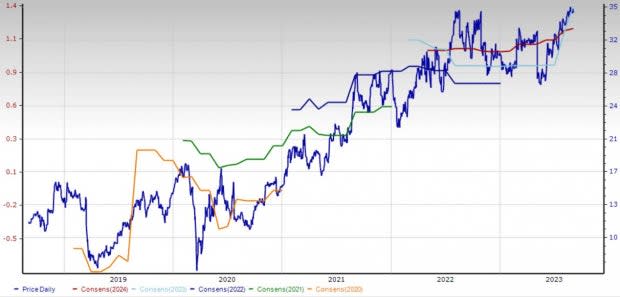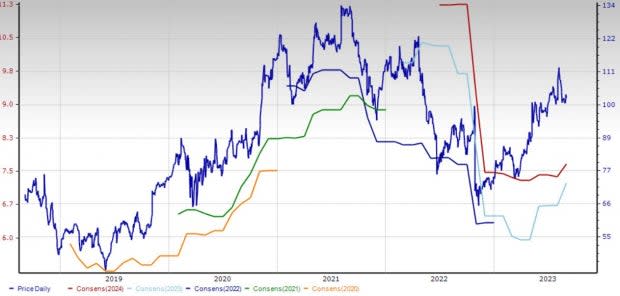4 Stocks to Buy in a Booming Outpatient Home Health Industry
The pandemic altered the nature and dynamics of the healthcare industry. The Zacks Medical - Outpatient and Home Healthcare industry, after struggling with lower outpatient clinic visits and inability to provide quality home healthcare, has gradually shifted to digital healthcare treatment. In the past few years, there has been a significant rise in demand for telemedicine-focused online medical and artificial intelligence (AI)-powered technology services. Post-pandemic, many healthcare companies that were traditionally not technology-based transformed to survive in the market. Per a report by Grand View Research, the global healthcare analytics market was valued at $35.3 billion in 2022 and is expected to expand at a CAGR of 21.4% between 2023 and 2030. Another factor prompting these MedTech players to embrace digital healthcare is the skyrocketing healthcare costs.
On a positive note, rising dependence on telehealth and AI is likely to help the industry thrive in the near term. DaVita Inc. DVA, Encompass Health Corporation EHC, Option Care Health, Inc. OPCH and RadNet, Inc. RDNT are likely to gain from the prospects.
Industry Description
The industry comprises companies that offer ambulatory care in an outpatient setting or at home. They use advanced medical technologies for diagnosis, treatment and rehabilitation services. The players include operators of HMO medical centers, kidney dialysis centers and other outpatient care centers. After navigating a tough pandemic era, the payers and providers have been seeing steady growth on the back of innovation in services. This buoys optimism about prospects over the next few years, although persistent inflation in consumer prices could dent the outlook. The potential for scaling up innovation, prompted by the pandemic’s pressure on the healthcare system, is an added plus. Also, the acceleration of value-based care models and the increasing application of technology across the healthcare industry are likely to continue in the long run.
Major Trends Shaping the Future of the Outpatient and Home Healthcare Industry
Cost Effectiveness: The primary advantage of outpatient clinics is cost-effectiveness. Outpatient medical care clinics do not retain patients for long hours (overnight) or charge exorbitantly. Modern-day outpatient clinics offer a broad spectrum of treatment and diagnostic options and even minor surgical procedures. Financial incentives like health plans and government program payment policies supporting services in lower-cost care settings have also been driving outpatient care.
Additionally, with value-based models of care steadily emerging as the future of healthcare, the shift from fee-for-service (FFS) to alternative payment models (APM) is an ongoing parallel trend. FFS will be crucial to care organizations as a benchmark through which providers can assess APM.
AI’s Dominant Role: AI has been a roaring success in healthcare. It is no wonder that it has taken the outpatient and home healthcare space by storm. Outpatient companies prefer bots and automated techniques for managing health information. With the help of AI, hospitals have been achieving better outcomes, with patients receiving more efficient and personalized care. The outpatient industry has been generating huge profits from Electronic Health Records and ePrescriptions.
The most visible area where AI can make a significant difference is in mental healthcare at home. Addressing the most prevalent mental health conditions among home care patients —depression, anxiety and dementia — is essential to improve overall patient well-being. In recent years, complex machine learning algorithms have become capable of analyzing large datasets of patient information, including clinical and social diagnoses. These systems can alert caregivers regarding potential triggers or warning signs of mental health deterioration.
Dependence on Telehealth: The pandemic caused a decline in outpatient clinic visits where home healthcare providers struggled to offer quality care due to the risk of exposure to the virus. Though the impact of the pandemic has been far-reaching, it has accelerated healthcare innovation. Home healthcare can gain from the benefits provided by Medicare (and several other payers) that comprise a broad range of services that can be delivered in a patient’s home, including post-operative and chronic wound care. Home healthcare has seen a surge in the utilization of the telehealth platform in response to the pandemic. With the rise in elderly population and the increasing costs of in-person health care, the demand for home-based health care will emerge. People with chronic illnesses and disabilities also require home-based care.
The rising demand for remote patient monitoring (RPM) has considerably driven the demand for wearable technology to monitor patient’s health. Although wearables have been popular for several years, their integration with AI has recently increased their popularity immensely and has become a powerful home healthcare tool. AI technology-powered RPM enables healthcare firms to provide consistent patient care without occupying space in their hospitals and facilities, thus reducing overcrowding.
Staffing Shortages: The U.S. healthcare industry has been experiencing a severe shortage of workers at every level, worsened by the COVID-19 pandemic. Among support personnel, there is a laxity of home health aides. The increasing international migration of health workers may aggravate health workforce shortfalls, especially in low-income and lower-middle income countries. Another reason for the acute staffing shortage is high burnout due to physical, emotional and mental exhaustion. Thus, these overworked employees are leaving the profession at an accelerating rate.
Healthcare staffing shortages lead to poor patient outcomes that can include hospital-acquired infections, patient falls and increased probabilities of death. With a lesser number of staff available in hospital settings for patient care, there has been a gradual shift toward home healthcare for non-critical patients who can be monitored remotely.
Zacks Industry Rank
The Zacks Medical - Outpatient and Home Healthcare industry falls within the broader Zacks Medical sector. It carries a Zacks Industry Rank #41, which places it in the top 16% of nearly 250 Zacks industries.
The group’s Zacks Industry Rank, which is basically the average of the Zacks Rank of all the member stocks, indicates bleak near-term prospects. Our research shows that the top 50% of the Zacks-ranked industries outperforms the bottom 50% by a factor of more than 2 to 1.
Before we present a few outpatient home health stocks that you may want to consider for your portfolio, let’s take a look at the industry’s recent stock-market performance and valuation picture.
Industry's Stock Market Performance
The industry has underperformed both its sector and the Zacks S&P 500 composite in the past year.
The industry has declined 1.9% over this period against the S&P 500’s rise of 14.9%. The broader sector has declined 0.4% in the same time frame.
One Year Price Performance

Image Source: Zacks Investment Research
Industry's Current Valuation
On the basis of the forward 12-month price-to-earnings (P/E), commonly used for valuing medical stocks, the industry is currently trading at 19X compared with the S&P 500’s 19.5X and the sector’s 22.2X.
Over the last five years, the industry has traded as high as 24.9X and as low as 16.6X, with the median being at 19.5X, as the charts below show.
Price-to-Earnings Forward Twelve Months (F12M)

Image Source: Zacks Investment Research
Price-to-Earnings Forward Twelve Months (F12M)

Image Source: Zacks Investment Research
4 Outpatient and Home Healthcare Stocks to Add Right Now
Encompass Health: Encompass Health, the owner and operator of inpatient rehabilitation hospitals in the United States, reported its second-quarter 2023 results in August. The company saw a robust uptick in its overall top line, primarily driven by increased volumes. It also recorded growth in total discharge, including same-store growth, during the period. Net revenue per discharge growth was also seen. Management also increased Encompass Health’s 2023 guidance to reflect its strong first-half results and updated expectations for the year's balance.
EHC currently sports a Zacks Rank of 1 (Strong Buy).
The Zacks Consensus Estimate for Encompass Health’s 2023 earnings suggests growth of 18.9%. The company’s return on equity (ROE) of 18.3% compares favorably with the industry’s 6.9%.

Image Source: Zacks Investment Research
Option Care Health: Option Care Health is a renowned independent provider of home and alternate site infusion services. In July, the company announced its second-quarter 2023 results, where it registered a solid uptick in its net revenues. At the time of the earnings release, Option Care Health confirmed that it had terminated its earlier-announced merger agreement with Amedisys, Inc. and received cash payment on behalf of Amedisys.
OPCH sports a Zacks Rank of 1. You can see the complete list of today’s Zacks #1 Rank stocks here.
For this Bannockburn, IL-based company, the Zacks Consensus Estimate for 2023 revenues suggests growth of 8.4%. The same for earnings indicates an increase of 71.1%.
The company’s ROE of 17.3% compares favorably with the industry’s 6.9%.

Image Source: Zacks Investment Research
RadNet: RadNet is a renowned provider of freestanding, fixed-site outpatient diagnostic imaging services through a network of owned or operated outpatient imaging centers. Last month, RadNet announced its second-quarter 2023 results, where it registered a solid uptick in its net revenues. Excluding revenues from its AI reporting segment, revenues from the Imaging Centers reporting segment were also strong. The company’s aggregate procedural volumes and same-center procedural volumes also increased year over year in the reported quarter.Management also confirmed that RadNet is currently experiencing increasing enrolment as it rolls out its Enhanced Breast Cancer Detection program.
RDNT flaunts a Zacks Rank of 1.
For this Los Angeles, CA-based company, the Zacks Consensus Estimate for 2023 revenues suggests growth of 12.1%. The same for earnings indicates a surge of 130%.
The company’s historical cash flow growth of 19.4% compares favorably with the industry’s 10.4%.

Image Source: Zacks Investment Research
DaVita: DaVita, a renowned global comprehensive kidney care provider, reported its second-quarter 2023 results in August. The company registered an uptick in its overall top line and dialysis patient service revenues during the period. The upside in total U.S. dialysis treatments during the quarter was also recorded. The opening of several dialysis centers within the United States and overseas was also seen.
DVA carries a Zacks Rank of 2 (Buy).
For this Denver, CO-based company, the Zacks Consensus Estimate for 2023 revenues suggests growth of 2.1%. The same for earnings indicates an increase of 9.4%. The company’s ROE of 60.7% compares favorably with the industry’s 6.9%.

Image Source: Zacks Investment Research
Want the latest recommendations from Zacks Investment Research? Today, you can download 7 Best Stocks for the Next 30 Days. Click to get this free report
DaVita Inc. (DVA) : Free Stock Analysis Report
RadNet, Inc. (RDNT) : Free Stock Analysis Report
Encompass Health Corporation (EHC) : Free Stock Analysis Report
Option Care Health, Inc. (OPCH) : Free Stock Analysis Report
